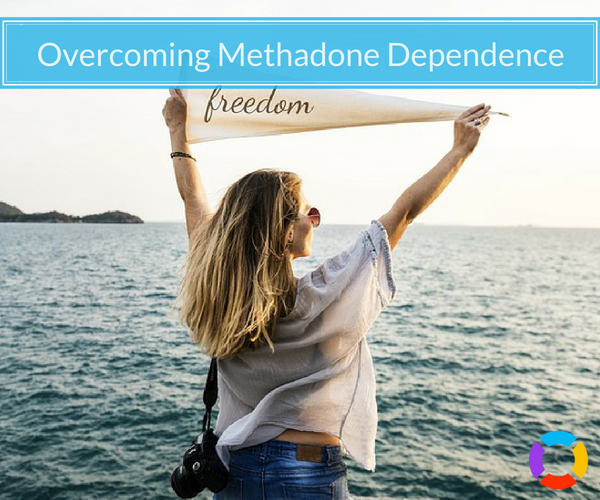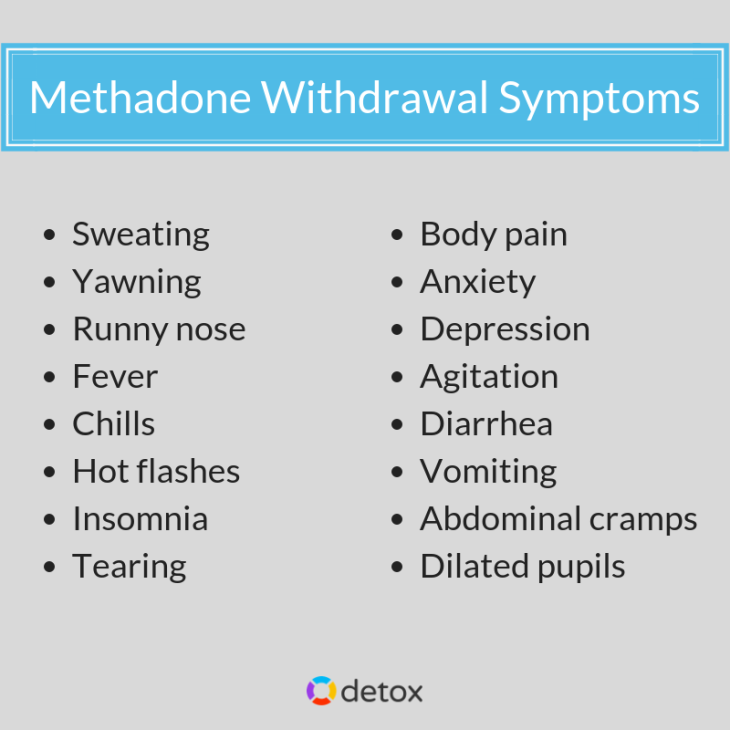Methadone Detox: Signs, Symptoms & Tips to Help YOU Detox from Methadone

Freedom from methadone addiction may seem like something you won’t ever achieve if you’re deep in the struggle of addiction to this powerful opiate, but there is help and you CAN get past these methadone withdrawal symptoms with help.
Methadone is a strong opioid agonist drug that creates intense effects even when taken as prescribed. Even though many Americans are being treated safely with methadone every day either for pain or for the issue of opioid addiction, the drug can also cause euphoria and relaxation, which is why it is so often abused. Those who misuse it can experience a host of problems, one of which is dependence. The safest, most effective way to overcome this and avoid addiction is to attend methadone detox.
Unfortunately, even those who take methadone as prescribed can become dependent on the drug. Dependence can also lead to abuse, as well as other issues, such as an uncomfortable, and sometimes even life-threatening, withdrawal syndrome. The best way for a person to be treated with this issue is in a professional detox facility that offers intensive, medically supervised withdrawal treatment.
If you or someone you love has become dependent on methadone and the problem has gotten out of control, don’t worry. There are plenty of safe, reliable medical detox centers near you where you can get the help you need. Just call 800-996-6135 now to get the help you need.
Methadone Abuse and Addiction
According to the Center for Substance Abuse Research, methadone is a narcotic analgesic or an opioid drug. It is synthetically created and has many uses, chief among them being a treatment medication for opioid addiction. When individuals take methadone as directed, they will not experience euphoria or the other high-inducing symptoms caused by large doses of the drug. However, people still abuse methadone often.
- As stated by the Drug Enforcement Administration, 2.46 million people admitted to having used methadone for non-medical purposes at least once in their lives in a 2011 study.
- People often abuse methadone because there aren’t any safeguards placed in the drug to protect it from abuse. This makes it extremely easy to misuse the substance.
- People often start out wanting to take methadone safely and to avoid further opioid abuse, but unfortunately, many relapse at some point during recovery. When this happens, methadone is often an easy target for abuse.
- Finally, methadone is encountered in large amounts on the black market. Because the drug is synthetic, it can easily be manufactured, bought, or stolen for nefarious purposes.
Methadone, like other opioids, is addictive in its own right and able to create dependence and tolerance as well. People who take it as a treatment drug are often constantly warned to take it safely and carefully, but abuse still occurs.
Methadone Withdrawal

Some of the worst withdrawal symptoms from Methadone will last a few weeks or months depending on unique factors relevant to the user. Treatment and the help of a methadone detox center can reduce the impact that withdrawal will have on your physical and mental well being.
A person might need to go through medically assisted methadone withdrawal for two reasons: either they have been misusing methadone or they have been maintained on the drug and are ready to end their maintenance. According to the National Institute on Drug Abuse, methadone maintenance treatment (MMT) should last at least a year, and after this point, a person can decide with their doctor whether to stay maintained on the drug or to be weaned off it.
One should NEVER attempt to go through methadone withdrawal on one’s own and without the help of medical treatment, let alone going through the experience cold turkey. This can be extremely unsafe.
Methadone withdrawal is similar to other types of opioid withdrawal in that it feels similar to the flu and produces uncomfortable, even extremely painful symptoms. As the National Library of Medicine states, the common symptoms of methadone withdrawal include
- Sweating
- Yawning
- Runny nose
- Fever
- Chills
- Hot flashes
- Insomnia
- Tearing
- Muscle, bone, and joint pain
- Anxiety
- Depression
- Agitation
- Diarrhea
- Vomiting
- Abdominal cramps
- Dilated pupils
Withdrawal from methadone usually starts later than other types of opioid withdrawal because the drug’s effects are so long-lasting. You will likely begin to see withdrawal effects begin around 30 hours after your last use of the drug. After this, symptoms may last between two and three weeks.
Dangers of Methadone Withdrawal
Like all kinds of drug withdrawal, methadone withdrawal has its own dangers and risks. Many people believe that, because opioid withdrawal is similar to the flu, it cannot be life-threatening, but this is untrue. Methadone withdrawal can cause perilous symptoms.
Depression
The depression associated with opioid withdrawal can be brutal. It is always difficult to be certain how severe the symptoms will become beforehand because every individual is different. However, depression during opioid withdrawal has the potential to cause suicidal ideation. This is why every person who is suffering from opioid withdrawal must receive an assessment for any co-occurring mental disorders and the appropriate treatment.
Anxiety
The issues associated with withdrawal-induced anxiety are similar. Assessments should also be made of the risk of serious anxious effects with any opioid withdrawal patient.
Dehydration
The symptoms caused by methadone withdrawal can all work together to create dehydration. For example, methadone withdrawal can potentially make you sweat profusely, vomit, and experience diarrhea. Your body will lose considerable liquid, putting you at risk for dehydration if you are not replenishing these fluids.
Relapse
Naturally, relapse is always the most dangerous potential side effect of withdrawal. Methadone withdrawal can sometimes be so painful that a person going through the experience may return to abusing the drug just to make the pain stop. Without the proper care, this could potentially happen during anyone’s opioid withdrawal experience.
- Relapse is the most dangerous at this time, as your tolerance will have diminished for the drug.
- Once relapse occurs, many people overdose on a much smaller amount of the drug, leading to more deadly overdoses occurring during this point than at any other point in opioid addiction or recovery (NLM).
As you can see, it is not safe to go through methadone withdrawal alone, but the fortunate truth is that you don’t have to. There are plenty of treatment facilities that offer safe, effective, and personalized methadone detox services across the country.
Call now to find methadone detox centers near you!
How Long Do Methadone Effects Last After Detox?
Withdrawal from methadone usually causes symptoms that last about two to three weeks, and most detox centers will offer patients care that lasts around 30 days or so. However, there is a potential you may experience lingering symptoms that last after detox has ended. The experience of these symptoms is called the post-acute withdrawal syndrome or PAWS.
PAWS can last as long as several months after acute withdrawal has ended. The symptoms most associated with opioid-related PAWS are anxiety, depression, and sleep problems, but some individuals also struggle with fatigue, dysphoria, and irritability.
What Happens in Methadone Detox?
In methadone detox, patients are treated for methadone withdrawal and allowed to slowly put an end to their methadone dependence. This program itself does not treat addiction but simply focuses on dependence.
- Usually, you and your doctor will discuss your needs and decide on a tapering schedule. It will involve slowly weaning you off the methadone a little at a time, so you do not experience the severe withdrawal symptoms all at once.
- Detox may also involve behavioral therapy, frequent check-ups, and other options that will make your withdrawal safer and more stable.
- In some cases, especially in the case of those who have been maintained on methadone for years, detox may take longer than the usual 30 days so as not to rush you through the experience too quickly.
Afterwards, your doctor will want to help you focus on your recovery and on making sure you stay sober. If you have not yet attended addiction treatment, you will need to. If being weaned off of methadone was a later step in your recovery, you will still probably need check-up or booster appointments to make sure everything in your recovery is going smoothly during and after detox.
Inpatient or Outpatient Methadone Detox?
When trying to choose between inpatient and outpatient methadone detox, it is important to ask yourself several questions. In doing this, you can determine which program may be better for your needs.
Have I been maintained on methadone for a long time?
- If so, you have probably already been through a long-term addiction treatment program. If this is the case, you may not need the intensive help provided in inpatient treatment.
- If not, you could be going through recovery for the first time or starting with detox. If this is the case, inpatient care might be a better fit.
Have I tried to stop before and been unsuccessful?
- If yes, you may want to seek inpatient care to receive the added support it provides. However, if you have lots of support at home, you may not need this option.
Do I have co-occurring mental disorders, physical disorders, or other serious issues along with my opioid dependence?
- If yes, you may want to seek out inpatient care. Those with multiple issues in need of treatment are often more likely to find additional care options in inpatient centers.
What Quitting Is Really Like?
You know you are ready to quit methadone, but it won’t be easy. This is why it is so important to ask for help and why following the instructions and suggestions of your doctor is necessary as well. Remember, going through methadone detox shouldn’t happen overnight, especially if your body has relied on the drug for a long time. Instead, think of it as another step in your recovery journey.
Would you like to learn more about methadone detox or find detox centers in your area? Just call 800-996-6135 today and take the first step toward recovery.
Sources
- Center for Substance Abuse Research. (2016). Methadone.
- Drug Enforcement Administration. (2014). Methadone (Trade Names: Methadose®, Dolophine®; Street Names:Fizzies, Amidone, Chocolate Chip Cookies).
- National Institute on Drug Abuse. (2018). Principles of Drug Addiction Treatment: A Research-Based Guide (3rd Edition)- How Long Does Drug Addiction Treatment Usually Last?
- U.S. National Library of Medicine. (2016). Opiate and Opioid Withdrawal.

